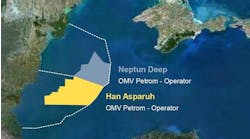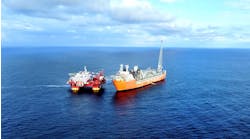Britain in Vietnam BP's recent discovery of Orchid Fields sets scene for new theatre of gas operations
Other UK oil companies in Nam Con Son have high hopes of discoveries
Jeremy Beckman
Editor
London
UK oil companies have built a comfortable niche in Vietnam, helped partly by the US' trade embargo. The contingent is headed by BP, which today is the leading foreign acreage holder off Vietnam after Vietsovpetro. It participates in four production sharing contracts, three as operator, and it has drilled more wells - at least 10 as operator - and acquired more seismic than any other foreign oil company.
In 1992, BP and its alliance partner Statoil farmed into acreage held by ONGC, which brought BP operatorship of blocks 5.2 and 06. The investment in 06 looks to have paid off already, following confirmation last September of two large gas discoveries, Lan Tay and Lan Do.
Wildcat drilling started in this block in December 1992, following a 1,000-line kilometre 2D seismic survey. Indications of something special were raised when a gas blowout struck the operating semisubmersible Actinia. Further 2D and 3D shoots were then performed, it is believed, over this gaseous area and over block 12.
Three more wells were drilled in block 06 in 1993, including an observation well on the Lan Tay prospect. Last May, Actinia returned to this site for further monitoring. Then in August, the first appraisal well was drilled on this discovery.
BP finally dropped its assiduously maintained tight hole status in September, announcing that early estimates put combined reserves for the prospects at 2 tcf. During tests, it said, flow rates reached more than 80 mcf/d.
Lack of forward planning by the state on Vietnam's gas infrastructure may have contributed to BP's tight-lipped stance. The block 06 finds are currently stranded 370 km from the coast. In addition, one of the 1993 wells is thought to have encountered gas with high CO2( content, which would affect the commerciality of the operation if treatment facilities had to be installed.
However, BP Vietnam's president, Mike Yeldham, was subsequently quoted in a Hanoi newspaper as saying that the company expected to spend $1 billion on a pipeline and production facilities offshore, and perhaps a further $1 billion on power or fertilizer plants which could utilize the gas.
Exploration manager Chris Sladen also said that work would resume on BP's 16,000 sq km of DaNang acreage off central Vietnam. Gas was discovered here during the first three-year exploration phase, but it was too heavily polluted with CO2. However, more drilling is likely this year employing new models for CO2 prediction developed by BP's research centre in Sunbury, UK.
Con Son first
Less spectacular, though also significant, was Lasmo's gas find in Block 4.2. The first commitment well on this PSC tested at 2 mcf/d and 40b/d of condensate from the shelf sands of the Middle Miocene Mang Cau formation.
This is not a commercial discovery, but it is the first recorded find in the northern Con Son Basin. Two further commitment wells are due to be drilled back-to-back shortly. Thereafter, the PSC contract is subject to two one-year extensions, should Lasmo and partners Union Texas and Cieco so wish.
Less lucky in the South Con Son Basin was Edinburgh-based Cairn Energy, operator of block 22. A year ago Cairn brought in Kerr McGee and Seagull Energy as partners; but their expertise worked no charms when the first wildcat was sunk to a T/D of 1,800 metres.
The operation was plugged and abandoned as a dry hole, and the licence partners subsequently relinquished the block. Prior exploration had comprised seismic shoots by Cairn and earlier by IPL.
Cairn retains 22.5% of Enterprise's Block 17 further north, where a small 2D seismic programme was shot late last year. This is being incorporated into an assessment of the block: a decision is due on whether to extend the PSC.
Off central Vietnam, there has been no activity in the IPL-operated block 115 since the first well was spudded in 1991. According to one of three UK partners in the block, Clyde Petroleum, discussions on its future are being held with the authorities. Monument and Pict (now owned by Premier) are the other UK venturers.
Much is expected, though little has yet delivered, from British Gas' Con Son Basin block 4.1. The first well, Song Tien 1X, was drilled in the Middle and Upper Miocene sands of a basement fault block last June. According to analyst Wood Mackenzie, after reaching a T/D of 3,900 metres, downhole logs revealed only shows of gas, leading to plugging and abandonment without testing.
Last year, ARCO picked up 50% of this block and is also picking up the cost of the two commitment wells (the second may already have been spudded). If substantial gas is found, it would tie in neatly with the gas highway pipeline being proposed from the Con Son to Vung Tau.
In any case, British Gas could well be a key player in such a project. The company's strategy is to participate in gas infrastructure projects in developing provinces. It is a member of a downstream consortium in the Philippines; it has a technical co-operation agreement with ONGC; and in Vietnam it is already part of a three-way consortium studying exploitation of associated gas from the Bach Ho oilfield.
Enterprise focuses efforts on oil in basement play
One of the first foreign operators to build up acreage off Vietnam was UK independent Enterprise Oil. The company acquired operatorship of two blocks in the Nam Con Son Basin, where it began drilling in late 1989, and subsequently also interests in three Fina-operated blocks adjoining Malaysian waters.
Following extensive drilling programmes, Enterprise recently decided to relinquish 21 and pull out of the Fina blocks. Now it is concentrating its efforts on Block 17.
New target
Enterprise has already drilled three wells in this block, but these were targeting Miocene and Oligocene sands. Having shot and interpreted further seismic, it now intends to drill the basement rock. According to Asia-Pacific region manager Joe Woolf, if oil were found here, "flow rates would be much higher, so the cost of any development would be low. The ingredients are attractive."Amongst the encouraging factors were Mitsubishi's promising oil discoveries last year in Block 15.2 and Petronas' success in Block 01. Currently, Enterprise holds 77.5% of 17, but is looking to farm out to another partner. The first phase of the PSC expires this spring, after which there would be an obligation to drill two wells and shoot a further 1,000 km of seismic.
According to Woolf, the terms under this PSC would be significantly better than those for newly licensed Vietnamese blocks. A 50 MM bbl find could be developed economically under existing terms, he says, but under the tougher new fiscal regime, 150 MM bbl is a more realistic figure.
Nevertheless, Enterprise still plans to apply for new blocks should suitable opportunities arise.
Copyright 1995 Offshore. All Rights Reserved.


